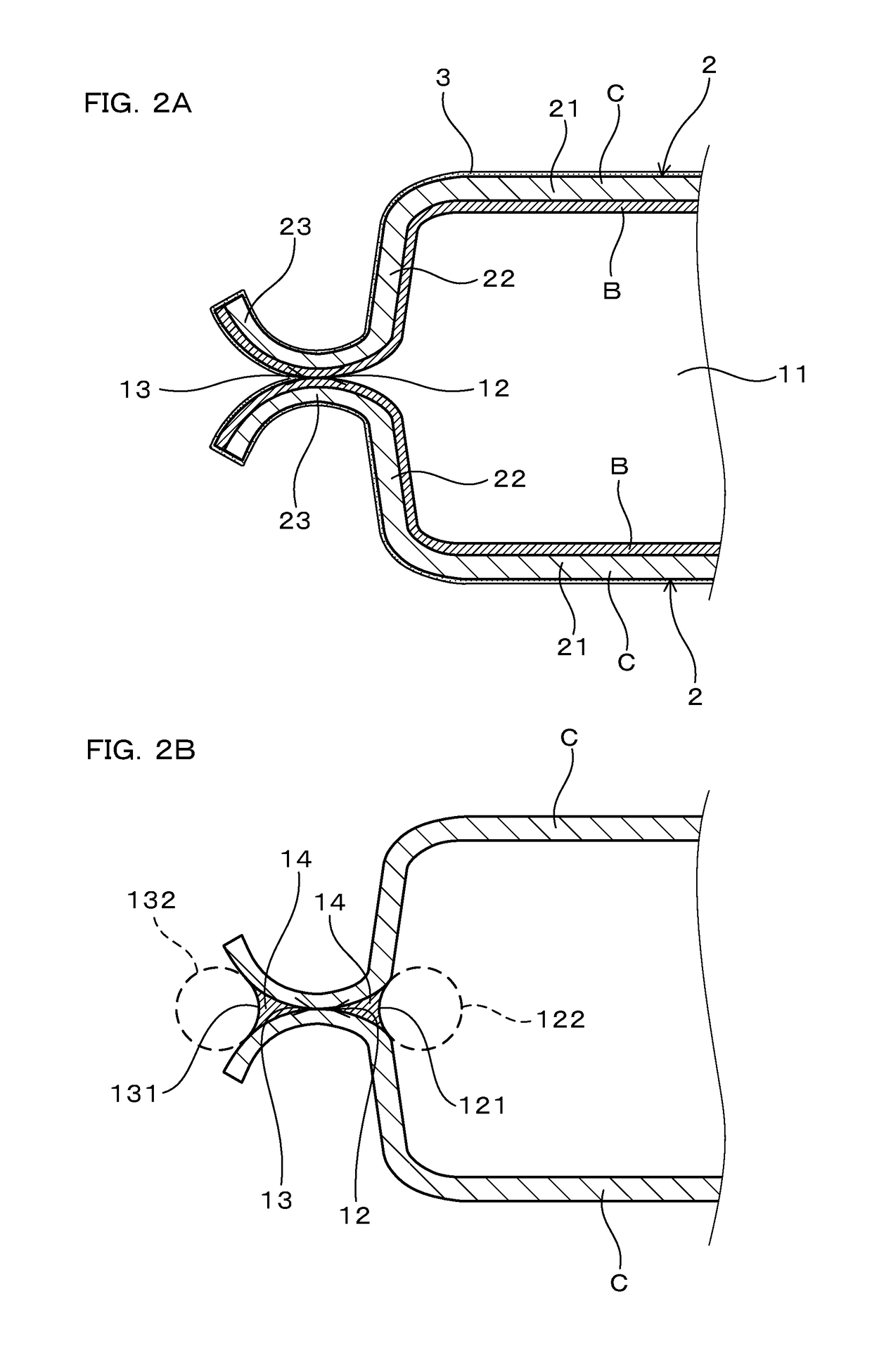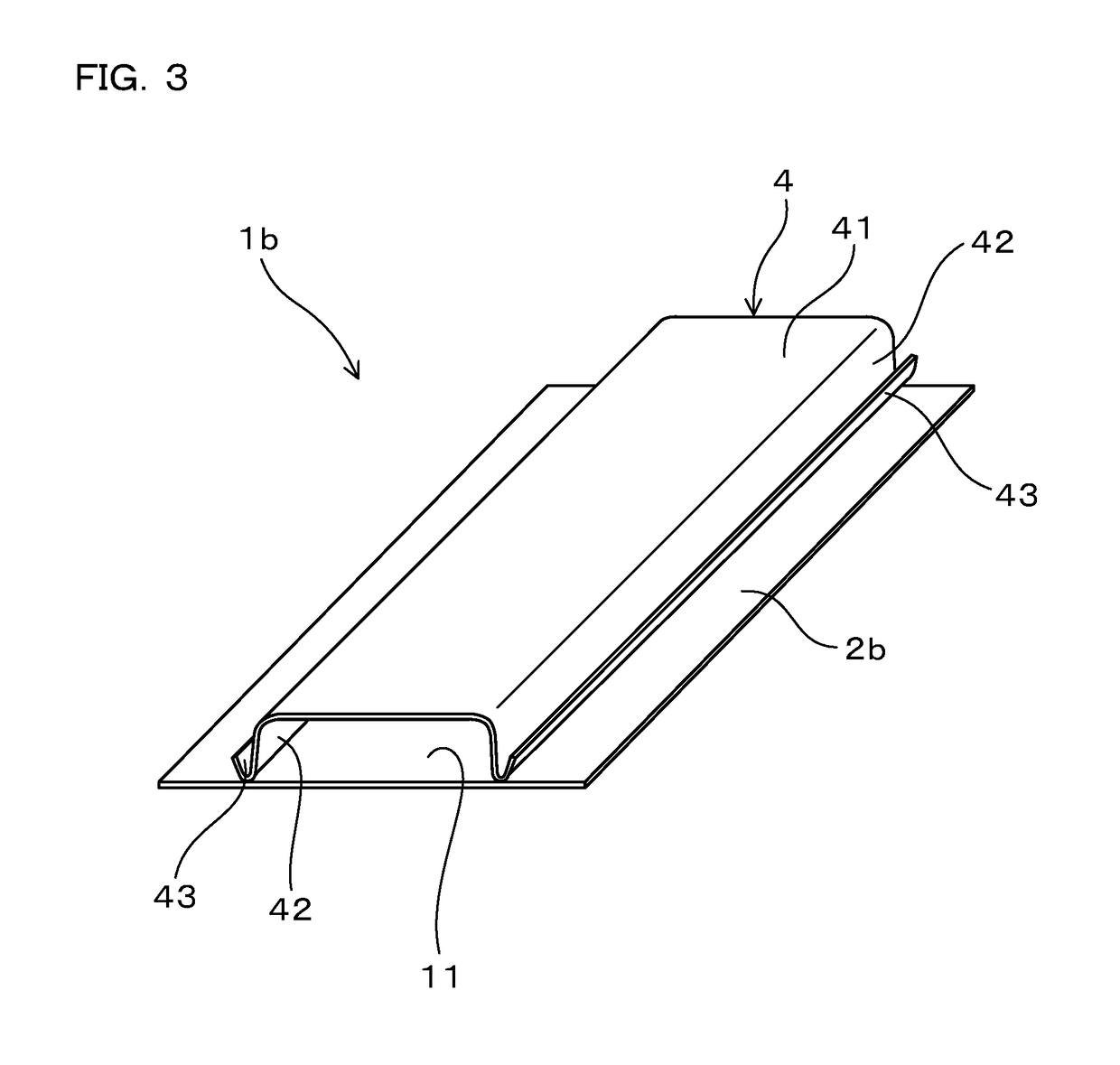Brazing method
a brazing method and aluminum material technology, applied in the direction of soldering apparatus, manufacturing tools, light and heating equipment, etc., can solve the problems of inability to use, degrade the quality of the brazing joint(s), and easy deformation of the brazing surface, so as to reduce the consumption of flux, the effect of low oxygen concentration state and easy brazing
- Summary
- Abstract
- Description
- Claims
- Application Information
AI Technical Summary
Benefits of technology
Problems solved by technology
Method used
Image
Examples
working examples
Example 1
[0078]Working examples of the brazing method will be explained with reference to the drawings. An object to be processed 1 of the present example is constituted from two brazing sheets 2 as shown in FIGS. 1 and 2, and a tube-shaped hollow portion 11 surrounded by the two brazing sheets 2 is present. The brazing sheet 2 of the present example is a single-sided brazing sheet in which a filler metal layer B is clad onto one surface of a core layer C as shown in FIG. 2(a). Each brazing sheet 2 has a top wall 21, and a pair of side walls 22 that are formed by folding the top wall 21 at both ends thereof in the sheet width direction. The pair of side walls 22 extend from the ends of the top wall 21 toward the filler metal layer B side in the thickness direction of the top wall 21. In addition, at a tip end of each side wall 22, a flange part 23 is formed by folding back the brazing sheet 2 towards the top wall 21 side.
[0079]The two brazing sheets 2 are disposed such that the fill...
example 2
[0111]The present example is an example of the brazing method of an object to be processed 1b that includes another component other than the brazing sheet 2. The object to be processed 1b of the present example, as shown in FIGS. 3 and 4, was constituted from a planar brazing sheet 2b and an upper component 4 placed on the brazing sheet 2b, and there was a tube-shaped hollow portion 11 surrounded by the brazing sheet 2b and the upper component 4. It is noted that the reference numbers used in FIGS. 3 and 4 are the same as were used in Example 1 to indicate the same structural elements, etc. except as otherwise explained.
[0112]The upper component 4 was formed by folding an aluminum sheet of 0.4 mm thickness made of JIS A 3003 alloy, and had a similar shape to that of the brazing sheet 2 in Example 1. That is, as shown in FIGS. 3 and 4, the upper component 4 includes a top wall 41, a pair of side walls 42 that are formed by folding the top wall 41 at both ends thereof in the width dir...
example 3
[0120]The present example is an example of another configuration of the object to be processed 1 to which the brazing method is applicable. The brazing method can be applied to objects to be processed 1 of a variety of modes, provided that the object to be processed 1 is composed of aluminum material and has a hollow portion 11. FIGS. 5 to 7 show examples of such configurations of the objects to be processed 1 (1c, 1d, and 1e). It is noted that FIGS. 5 to 7 show the state in which brazing of the object to be processed 1 has been completed. The filler metal layer B in the brazing sheets 2 is melted by heating during the brazing and moves to an inner join part 12 and to an outer join part 13. For that reason, as shown in FIGS. 5 to 7, no filler metal layer B remains on the surface of the core layer C in the state in which brazing has been completed, except on the inner join part 12 and the outer join part 13.
[0121]For example, the object to be processed 1 may have an inner fin 5 inter...
PUM
| Property | Measurement | Unit |
|---|---|---|
| thermal decomposition temperature | aaaaa | aaaaa |
| thermal decomposition temperature | aaaaa | aaaaa |
| temperature | aaaaa | aaaaa |
Abstract
Description
Claims
Application Information
 Login to View More
Login to View More - R&D
- Intellectual Property
- Life Sciences
- Materials
- Tech Scout
- Unparalleled Data Quality
- Higher Quality Content
- 60% Fewer Hallucinations
Browse by: Latest US Patents, China's latest patents, Technical Efficacy Thesaurus, Application Domain, Technology Topic, Popular Technical Reports.
© 2025 PatSnap. All rights reserved.Legal|Privacy policy|Modern Slavery Act Transparency Statement|Sitemap|About US| Contact US: help@patsnap.com



